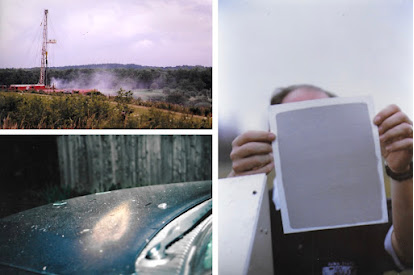Firms Drilling for Gas Would 'Destroy' Local State Game Lands
October 11, 2009PA Lawsuit Says Drilling Polluted Water
November 11, 2009Wastewater from natural gas drilling in New York State is radioactive, as high as 267 times the limit safe for discharge into the environment and thousands of times the limit safe for people to drink
As New York gears up for a massive expansion of gas drilling in the Marcellus Shale, state officials have made a potentially troubling discovery about the wastewater created by the process: It’s radioactive. And they have yet to say how they’ll deal with it. The information comes from New York
State’s Department of Environmental Conservation, which analyzed 13 samples of wastewater brought thousands of feet to the surface from drilling and found that they contain levels of radium 226, a derivative of uranium, as high as 267 times the limit safe for discharge into the environment and thousands of times the limit safe for people to drink.
The findings, if backed up with more tests, have several implications: The energy industry would likely face stiffer regulations and expenses, and have more trouble finding treatment plants to accept its waste—if any would at all. Companies would need to license their waste handlers and test their workers for radioactive exposure, and possibly ship waste across the country. And the state would have to sort out how its laws for radioactive waste might apply to drilling and how the waste could impact water supplies and the environment.
What is less clear is how the wastewater may affect the health of New Yorkers, since the danger depends on how much radiation people are exposed to and how they are exposed to it. Radium is known to cause bone, liver and breast cancers, and the EPA publishes exposure guidelines for it, but there is still disagreement over exactly how dangerous low-level doses can be to workers who handle it, or to the public.
The DEC has yet to address any of these questions. But New York’s Health Department raised concerns about the amount of radioactive materials in the wastewater in a confidential letter to the DEC’s oil and gas regulators in July.
“Handling and disposal of this wastewater could be a public health concern,” DOH officials said in the letter, which was obtained by ProPublica. “The issues raised are not trivial, but are also not insurmountable.”
The letter warned that the state may have difficulty disposing of the drilling waste, that thorough testing will be needed at water treatment plants, and that workers may need to be monitored for radiation as much as they might be at nuclear facilities.
Health Department officials declined to comment on the letter. The DEC sent an email response to questions about the radioactivity stating that “concentrations are generally not a problem for water discharges, or in solid waste streams” in New York State. But the agency did not directly address the radioactivity levels, which were disclosed in the appendices of the agency’s environmental review of gas drilling in the Marcellus Shale, released September 30.
The review did not calculate how much radioactivity people may be exposed to, even though such calculations are routinely completed by scientists studying radiation exposure. Yet the review concluded that radiation levels were “very low” and that the wastewater “does not present a risk to workers.” DEC officials declined to explain how they reached this conclusion.
Although the review pointed to a possible need for radioactive licensing and disposal for certain materials, and it looked at other states with laws aimed at radioactive waste from drilling, the DEC said there is no precedent for examining how these radioactive materials might affect the environment when brought to the surface at the volumes and scale expected in New York. And it said that more study is needed before the DEC can lay out precise plans to deal with the waste.



